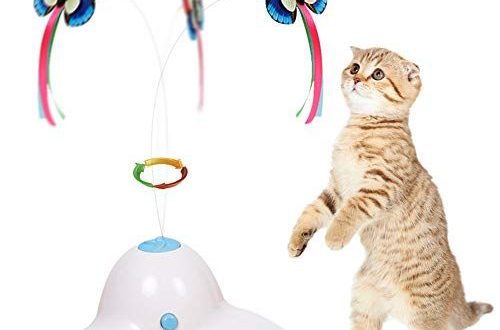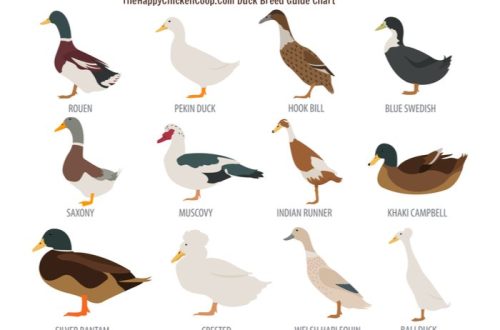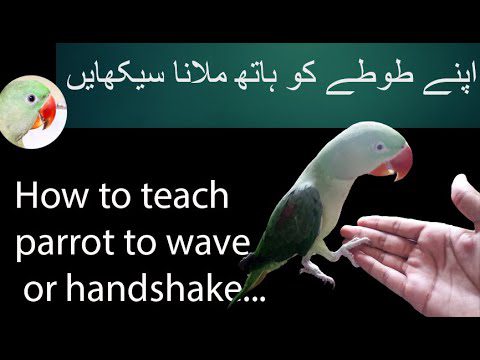
How to accustom a parrot to hands quickly: wavy, necklace, lovebird, effective ways to train
Parrots are smart and temperamental birds. They are happy to go to the hands of those they trust. Therefore, the main task of the owner is to make friends with his pet. The advice of experienced poultry farmers will tell beginners how to teach a parrot to handle.
Contents
Getting to know the bird
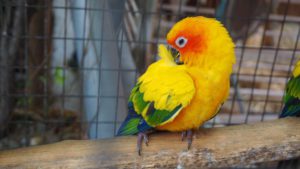
At first, it is better not to violate the territorial integrity of the parrot
Adapting to a new place of residence is difficult for all birds. Parrots endure it very painfully, their behavior often changes from active to anxious and withdrawn.. The first changes in the state of the bird can be noticed already on the way from the store to a new home for her. The parrot stops chirping, often flies from place to place or, conversely, sits motionless, carefully watching what is happening.
During the adaptation period, different options for bird behavior are possible:
- refusal to feed;
- stomach upset;
- periodic throwing around the cage;
- alarm cries;
- immobility and apathy.
Rules of conduct for the owner during the adaptation period:
- You can’t let the bird out of the cage. The parrot must first get used to the environment.
- No need to impose your society on the bird. You should not often approach the cage and talk to the parrot.
- The cage is installed in a place inaccessible to other pets. The room does not allow loud sounds and children’s games.
- The sound of a working TV should be quiet.
Recommended course of action:
- you need to talk with the bird, being at a distance of 2-3 meters from the cage;
- voice intonations should be gentle;
- during communication, you do not need to make sudden movements;
- food is placed neatly, slowly approaching the cage and affectionately talking to the bird.
The goal of the owner in the first days of the adaptation period is to make the bird feel secure.
Domestication
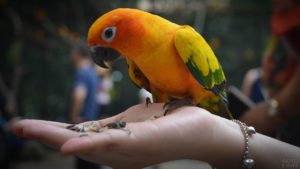
A treat in your hand will speed up the process of establishing a relationship with a parrot.
After the parrot calms down and begins to be active in behavior and eating food, the period of taming begins. The main goal of the owner at this time is to inspire confidence. Taming a parrot is a long process that requires patience and careful attention to the bird..
The most effective way to get your parrot interested and trusted is to feed it treats. Pet stores sell special feeding for this type of bird.
In addition to them, you can give:
- pieces of sweet fruit;
- fresh herbs;
- raw vegetables.
If the bird is afraid of the hand, pieces of food are attached to a toothpick or a cocktail straw and the food is pulled through the bars of the cage. Gradually, the parrot will get used to the owner and will cease to be afraid of his hands.
Parrots remember insults. They can forgive the bad attitude of the owner, with whom they have lived nearby for many years. But the new owner will be shunned for a long time.
How to accustom a wavy parrot to your hands
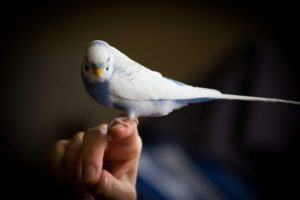
Young budgies are much easier to get along with than adults.
Budgerigars begin to be tamed in the same way: with the help of treats. Gradually, the bird will get used to it and begin to receive only positive emotions from the presence of the owner. The easiest way to win the trust of young individuals. With adults it is more difficult, they can be wary of the new owner for a long time. But you can get along with them too. There are several ways to make contact:
- speak affectionately;
- tasty food;
- correctly choose the moments for communication: the bird must be active, sleepy, and not afraid.
If it is not possible to attract the attention of a pet with a treat, you need to carefully observe it for a while.. It is important to understand his character, what he likes to do at a time when he believes that no one is watching him. Many budgerigars like to swing on a perch or ring a bell.
If the bird does not have a favorite toy, they put a variety of things in the cage: balls, colored pieces of paper, beautiful pebbles. When the parrot becomes interested in one of them, they begin the process of taming. Gradually move the favorite toy to their hand, thereby forcing the bird to climb onto the finger. Daily training will certainly lead to the desired result.
How to tame a necklace parrot
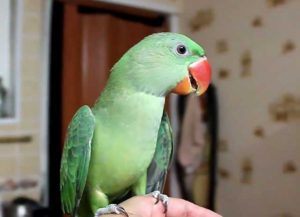
Finding an approach to a necklace parrot is not so easy
The necklace parrot is a bird with character. In his domestication, much depends on age and upbringing. If the parrot is older than three years, all the tricks of the owner about taming may be useless.. An adult bird can remain “wild” forever.
The methods of raising a necklace parrot are the same:
- gaining trust;
- feeding with treats;
- hand training.
Birds of this breed understand and remember intonations very well. They always recognize the false. Therefore, taming classes are carried out in moments of good mood and with a sincerely affectionate attitude towards the bird.
Taming stages:
- They are taught to calmly respond to the owner’s hand, which is next to the cage. At this stage, the palm should be motionless. At the same time, with the second hand, you can offer a treat on a toothpick or any other long stick. They talk affectionately.
- Slowly bringing the hand closer to the cage, they begin to move their fingers. If this did not frighten the bird, continue to accustom it to the hand. If the parrot is alarmed, stop moving your fingers. After a while, try again.
- Put your hand in the cage and repeat the learning process.
- They put a treat on the palm and offer it to the parrot. Repeat until the bird gets used to it and starts eating food.
- Move the treat closer to the middle of the palm, forcing the parrot to move along the arm.
Necklaces are one of the few breeds of parrots that can live in the wild and get their own food. By their nature, these are typically “enclosure” birds. The most susceptible to training are individuals raised by their parents. Adults caught in the wild may not make contact with a person until the end of their lives.
In taming a necklace parrot, communication is most effective when it is out of the cage.. You should not strive to approach him or gradually reduce the distance, because, obeying instinct, he will fly away. The necklace parrot needs to be interested in a toy or treat.
Taming the Lovebird
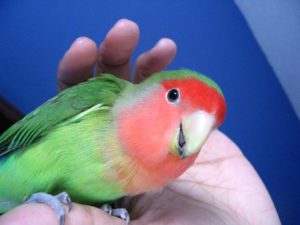
An apple or a grape can cement friendship with a lovebird
There is one peculiarity in taming lovebirds – these birds consider the territory of the cage to be theirs and actively protect it. If the parrot is not yet accustomed to and does not trust the owner, he can peck the hand extended into the cage. But the reason for this behavior may lie not only in the natural alertness of the bird.
Lovebirds often calmly sit on the owner’s shoulder, but may not go on the hands. Perhaps the bird is frightened by the previous owner, employees or visitors to the pet store. The fear of hands can also be caused by the fact that they caught the feathered one with them, and not with a net.
In this case, you need to try very hard to inspire absolute trust. As a rule, with due perseverance, several months are enough for this.
Favorite treats of lovebirds:
- carrot;
- an Apple;
- grapes;
- Bell pepper.
The methods of taming lovebirds are no different from those listed above.
We accustom to the hands of the parrot Rosella
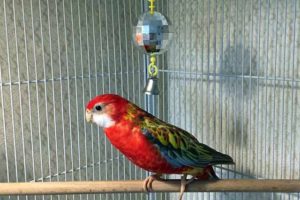
Rosella can be attracted to the hands of some bright trinket
Rosellas are smart parrots, with a docile but cautious personality. They are more difficult to get used to a person than budgerigars and lovebirds.
The basic principles of communication with the Rosellas are the same:
- gradualness;
- caress;
- lack of sudden movements;
- frequency of attempts.
In taming a parrot, you can use their natural curiosity. In this case, not only food is placed on the palm, but also some bright, shiny object. Over time, the bird will overcome fear and begin to stand on the palm, first with one paw, and then with both.
How to speed up the process
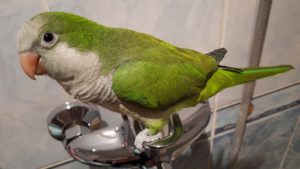
The main thing in the process of accustoming a parrot to hands is patience.
There are no quick fixes for taming parrots. The desired results are achieved gradually and unhurriedly. The speed of accustoming to the hand depends on many factors:
- the nature of the bird;
- her past experience;
- the conditions in which it is currently located.
In order to tame, it is important to use all the convenient moments. While walking a bird outside the cage, you can lure it by putting your favorite treat or toy on your hand. At the same time, they are treated affectionately, called by name, persuaded.
Learning difficulties
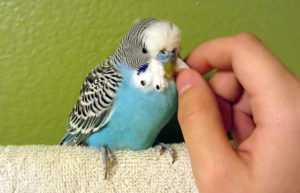
An unsuccessful attempt to establish contact with a parrot may be the last
If the bird does not make contact for a long time, and the owner runs out of patience, some owners decide to use the force method. It consists in wrapping the bird in a towel and communicating with it in this state. For those who do not want to completely spoil the relationship with their pet, it is better not to use such dubious methods.
A smart bird will definitely remember that it was in the hands of the owner, being in a defenseless state. This fear will be difficult to eliminate. Trimming the wings will not work either. If the parrot is afraid of the owner, he will run away from him on his feet.
A bird will become tame only when it begins to consider a person as part of a flock. This is possible only with full trust in the owner. It is achieved by patience, attention and affection – remember this.



